Angel
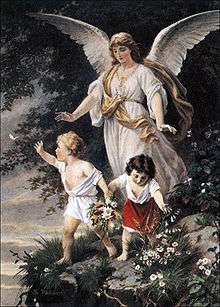
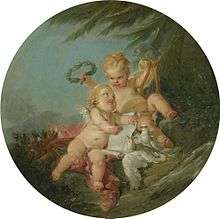
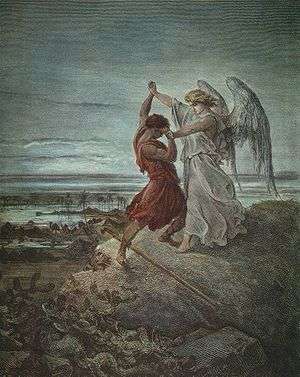
An angel is a low-ranked spiritual being superior to humans in power and intelligence.[1] In Christianity, Judaism, Islam, and Zoroastrianism angels are celestial beings that act as intermediaries between heaven and earth.[2] Most of them serve either as intermediaries between Heaven and Earth, or as guardian spirits.[2][3] Angels are referred to in connection with their spiritual missions; as for instance, the "angel which has redeemed", "an interpreter", "the angel that destroyed", "the messenger of the covenant", "angel of his presence", and "a band of angels of evil".[4] In Christian Science, the word "angel" is used to refer to an inspiration from God.
The use of the term has extended to refer to artistic depictions of the spirits, and it is also used figuratively to refer to messengers and harbingers, and to people who possess high qualities of goodness, purity, selflessness, intelligence, and/or beauty.[1][4]
In fine art, angels are usually depicted as having the shape of human beings of extraordinary beauty;[1][4] they are often identified using the symbols of bird wings, halos, and light.
Etymology
The word angel (pronounced /ˈeɪn.dʒəl/) in English is a blend of Old English engel (with a hard g) and Old French angele.[5] Both derive from Late Latin angelus "messenger", which in turn was borrowed from Late Greek ἄγγελος ángelos. According to R. S. P. Beekes, ángelos itself may be "an Oriental loan, like ἄγγαρος ['Persian mounted courier']."[6] The word's earliest form is Mycenaean a-ke-ro attested in Linear B syllabic script.[7][8]
The ángelos is the default Septuagint's translation of the Biblical Hebrew term mal’ākh denoting simply "messenger" without specifying its nature. In the Latin Vulgate, however, the meaning becomes bifurcated: when mal’ākh or ángelos is supposed to denote a human messenger, words like nuntius or legatus are applied. If the word refers to some supernatural being, the word angelus appears. Such differentiation has been taken over by later vernacular translations of the Bible, early Christian and Jewish exegetes and eventually modern scholars.[9]
Zoroastrianism
In Zoroastrianism there are different angel-like figures. For example, each person has one guardian angel, called Fravashi. They patronize human beings and other creatures, and also manifest God's energy. The Amesha Spentas have often been regarded as angels, although there is no direct reference to them conveying messages,[10] but are rather emanations of Ahura Mazda ("Wise Lord", God); they initially appeared in an abstract fashion and then later became personalized, associated with diverse aspects of the divine creation.[11]
Neoplatonism
In the commentaries of Proclus (4th century, under Christian rule) on the Timaeus of Plato, Proclus uses the terminology of "angelic" (aggelikos) and "angel" (aggelos) in relation to metaphysical beings. According to Aristotle, just as there is a First Mover,[12] so, too, must there be spiritual secondary movers.[13]
Abrahamic religions
Judaism
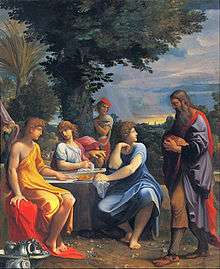
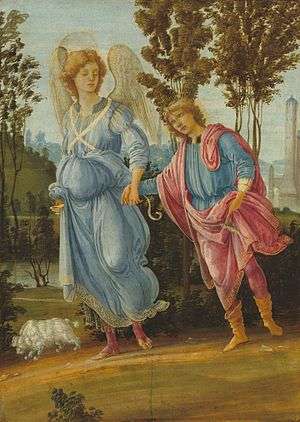
The Torah uses the (Hebrew) terms מלאך אלהים (mal'āk̠ 'ĕlōhîm; messenger of God), מלאך יהוה (mal'āk̠ YHWH; messenger of the Lord), בני אלהים (bənē 'ĕlōhîm; sons of God) and הקודשים (haqqôd̠əšîm; the holy ones) to refer to beings traditionally interpreted as angels. Later texts use other terms, such as העליונים (hā'elyônîm; the upper ones).
The term מלאך (mal'āk̠) is also used in other books of the Tanakh. Depending on the context, the Hebrew word may refer to a human messenger or to a supernatural messenger. A human messenger might be a prophet or priest, such as Malachi, "my messenger"; the Greek superscription in the Septuagint translation states the Book of Malachi was written "by the hand of his messenger" ἀγγέλου angélu. Examples of a supernatural messenger[14] are the "Malak YHWH," who is either a messenger from God,[15] an aspect of God (such as the Logos),[16] or God himself as the messenger (the "theophanic angel.")[14][17]
Scholar Michael D. Coogan notes that it is only in the late books that the terms "come to mean the benevolent semi divine beings familiar from later mythology and art."[18] Daniel is the first biblical figure to refer to individual angels by name,[19] mentioning Gabriel (God's primary messenger) in Daniel 9:21 and Michael (the holy fighter) in Daniel 10:13. These angels are part of Daniel's apocalyptic visions and are an important part of all apocalyptic literature.[18] Coogan explains the development of this concept of angels: "In the postexilic period, with the development of explicit monotheism, these divine beings—the 'sons of God' who were members of the Divine Council—were in effect demoted to what are now known as 'angels', understood as beings created by God, but immortal and thus superior to humans."[18] This conception of angels is best understood in contrast to demons and is often thought to be "influenced by the ancient Persian religious tradition of Zoroastrianism, which viewed the world as a battleground between forces of good and forces of evil, between light and darkness."[18] One of these is hāšāṭān, a figure depicted in (among other places) the Book of Job.
Philo of Alexandria identifies the angel with the Logos inasmuch as the angel is the immaterial voice of God. The angel is something different from God himself, but is conceived as God's instrument.[20]
In post-Biblical Judaism, certain angels took on particular significance and developed unique personalities and roles. Although these archangels were believed to rank among the heavenly host, no systematic hierarchy ever developed. Metatron is considered one of the highest of the angels in Merkabah and Kabbalist mysticism and often serves as a scribe; he is briefly mentioned in the Talmud[21] and figures prominently in Merkabah mystical texts. Michael, who serves as a warrior[22] and advocate for Israel (Daniel 10:13), is looked upon particularly fondly.[23] Gabriel is mentioned in the Book of Daniel (Daniel 8:15–17) and briefly in the Talmud,[24] as well as in many Merkabah mystical texts. There is no evidence in Judaism for the worship of angels, but there is evidence for the invocation and sometimes even conjuration of angels.[19]
According to Kabbalah, there are four worlds and our world is the last world: the world of action (Assiyah). Angels exist in the worlds above as a 'task' of God. They are an extension of God to produce effects in this world. After an angel has completed its task, it ceases to exist. The angel is in effect the task. This is derived from the book of Genesis when Abraham meets with three angels and Lot meets with two. The task of one of the angels was to inform Abraham of his coming child. The other two were to save Lot and to destroy Sodom and Gomorrah.[19]
Jewish philosopher Maimonides explained his view of angels in his Guide for the Perplexed II:4 and II
... This leads Aristotle in turn to the demonstrated fact that God, glory and majesty to Him, does not do things by direct contact. God burns things by means of fire; fire is moved by the motion of the sphere; the sphere is moved by means of a disembodied intellect, these intellects being the 'angels which are near to Him', through whose mediation the spheres [planets] move ... thus totally disembodied minds exist which emanate from God and are the intermediaries between God and all the bodies [objects] here in this world.— Guide for the Perplexed II:4, Maimonides
Maimonides had a neo-Aristotelian interpretation of the Bible. Maimonides writes that to the wise man, one sees that what the Bible and Talmud refer to as "angels" are actually allusions to the various laws of nature; they are the principles by which the physical universe operates.
For all forces are angels! How blind, how perniciously blind are the naive?! If you told someone who purports to be a sage of Israel that the Deity sends an angel who enters a woman's womb and there forms an embryo, he would think this a miracle and accept it as a mark of the majesty and power of the Deity, despite the fact that he believes an angel to be a body of fire one third the size of the entire world. All this, he thinks, is possible for God. But if you tell him that God placed in the sperm the power of forming and demarcating these organs, and that this is the angel, or that all forms are produced by the Active Intellect; that here is the angel, the "vice-regent of the world" constantly mentioned by the sages, then he will recoil.– Guide for the Perplexed II:4
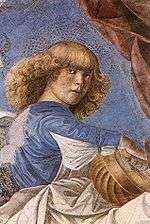
Jewish angelic hierarchy
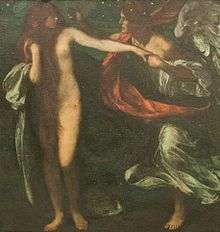
Maimonides, in his Yad ha-Chazakah: Yesodei ha-Torah, counts ten ranks of angels in the Jewish angelic hierarchy, beginning from the highest:
| Rank | Angel | Notes |
| 1 | Chayot Ha Kodesh | See Book of Ezekiel chs. 1 and 10 |
| 2 | Ophanim | See Ezekiel chs. 1 and 10 |
| 3 | Erelim | See Book of Isaiah 33:7 |
| 4 | Hashmallim | See Ezekiel 1:4 |
| 5 | Seraphim | See Isaiah 6 |
| 6 | Malakim | Messengers, angels |
| 7 | Elohim | "Godly beings" |
| 8 | Bene Elohim | "Sons of Godly beings" |
| 9 | Cherubim | See Talmud Hagigah |
| 10 | Ishim | "manlike beings", see Book of Genesis 18:2, Book of Daniel 10:5 |
Individual angels
From the Jewish Encyclopedia, entry "Angelology".[19]
- Michael (archangel) (translation: who is like God?), kindness of God, and stands up for the children of mankind
- Gabriel (archangel) (translation: God is my strength), performs acts of justice and power
(Only these two angels are mentioned by name in the Hebrew Bible; the rest are from extra-biblical tradition.)
- Jophiel (translation: Beauty of God), expelled Adam and Eve from the Garden of Eden holding a flaming sword and punishes those who transgress against God.
- Raphael (archangel) (translation: It is God who heals), God's healing force
- Uriel (archangel) (translation: God is my light), leads us to destiny
- Samael (archangel) (translation: Venom of God), angel of death—see also Malach HaMavet (translation: the angel of death)
- Sandalphon (archangel) (translation: bringing together), battles Samael and brings mankind together
Christianity
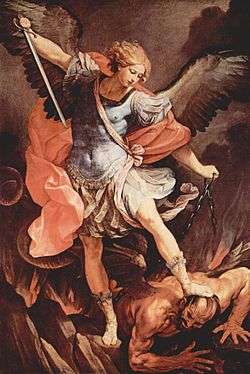
Later Christians inherited Jewish understandings of angels, which in turn may have been partly inherited from the Egyptians.[25] In the early stage, the Christian concept of an angel characterized the angel as a messenger of God. Later came identification of individual angelic messengers: Gabriel, Michael, Raphael, and Uriel. Then, in the space of little more than two centuries (from the 3rd to the 5th) the image of angels took on definite characteristics both in theology and in art.[26]
According to St Augustine, " 'Angel' is the name of their office, not of their nature. If you seek the name of their nature, it is 'spirit'; if you seek the name of their office, it is 'angel': from what they are, 'spirit', from what they do, 'angel'."[27] Basilian Father Thomas Rosica says, "Angels are very important, because they provide people with an articulation of the conviction that God is intimately involved in human life."[28]
By the late 4th century, the Church Fathers agreed that there were different categories of angels, with appropriate missions and activities assigned to them. There was, however, some disagreement regarding the nature of angels. Some argued that angels had physical bodies,[29] while some maintained that they were entirely spiritual. Some theologians had proposed that angels were not divine but on the level of immaterial beings subordinate to the Trinity. The resolution of this Trinitarian dispute included the development of doctrine about angels.[30]
The angels are represented throughout the Christian Bible as spiritual beings intermediate between God and men: "You have made him [man] a little less than the angels ..." (Psalms 8:4-5). The Bible describes the function of angels as "messengers" but does not indicate when the creation of angels occurred.[31] Christians believe that angels are created beings, based on (Psalms 148:2-5; Colossians 1:16): "praise ye Him, all His angels: praise ye Him, all His hosts ... for He spoke and they were made. He commanded and they were created ...". The Fourth Lateran Council (1215) declared that the angels were created beings. The Council's decree Firmiter credimus (issued against the Albigenses) declared both that angels were created and that men were created after them. The First Vatican Council (1869) repeated this declaration in Dei Filius, the "Dogmatic constitution on the Catholic faith".
Thomas Aquinas (13th century) relates angels to Aristotle's metaphysics in his Summa contra Gentiles,[32] Summa Theologica,[33] and in De substantiis separatis,[34] a treatise on angelology. Although angels have greater knowledge than men, they are not omniscient, as Matthew 24:36 points out.[35]
Interaction with angels

| “ | Forget not to show love unto strangers: for thereby some have entertained angels unawares.—Hebrews 13:2 | ” |
The New Testament includes many interactions and conversations between angels and humans. For instance, three separate cases of angelic interaction deal with the births of John the Baptist and Jesus Christ. In Luke 1:11, an angel appears to Zechariah to inform him that he will have a child despite his old age, thus proclaiming the birth of John the Baptist. In Luke 1:26 the Archangel Gabriel visits the Virgin Mary in the Annunciation to foretell the birth of Jesus Christ. Angels then proclaim the birth of Jesus in the Adoration of the shepherds in Luke 2:10.[36]
According to Matthew 4:11, after Jesus spent 40 days in the desert, "...the devil left him and, behold, angels came and ministered to him." In Luke 22:43 an angel comforts Jesus Christ during the Agony in the Garden.[37] In Matthew 28:5 an angel speaks at the empty tomb, following the Resurrection of Jesus and the rolling back of the stone by angels.[36]
In 1851 Pope Pius IX approved the Chaplet of Saint Michael based on the 1751 reported private revelation from archangel Michael to the Carmelite nun Antonia d'Astonac.[38] In a biography of Saint Gemma Galgani written by Venerable Germanus Ruoppolo, Galgani stated that she had spoken with her guardian angel.
Pope John Paul II emphasized the role of angels in Catholic teachings in his 1986 address titled "Angels Participate In History Of Salvation", in which he suggested that modern mentality should come to see the importance of angels.[39]
According to the Vatican's Congregation for Divine Worship and Discipline of the Sacraments, "The practice of assigning names to the Holy Angels should be discouraged, except in the cases of Gabriel, Raphael and Michael whose names are contained in Holy Scripture."[40]
The New Church
In the New Church, extensive information is provided concerning angels and the spiritual world in which they dwell from many years of spiritual experiences recounted in the writings of Emanuel Swedenborg. All angels are in human form with a spiritual body, and are not just minds without form.[41] There are different orders of angels according to the three heavens,[42] and each angel dwells in one of innumerable societies of angels. Such a society of angels can appear as one angel as a whole.[43] All angels originate from the human race, and there is not one angel in heaven who first did not live in a material body.[44] Moreover, all children who die not only enter heaven but eventually become angels.[45] The life of angels is that of usefulness, and their functions are so many that they cannot be enumerated. However each angel will enter a service according to the use that they had performed in their earthly life.[46] Names of angels, such as Michael, Gabriel, and Raphael, signify a particular angelic function rather than an individual being.[47] While living in one's body an individual has conjunction with heaven through the angels,[48] and with each person, there are at least two evil spirits and two angels.[49] Temptation or pains of conscience originates from a conflict between evil spirits and angels.[50] Due to man's sinful nature it is dangerous to have open direct communication with angels[51] and can only be seen when one's spiritual sight has been opened.[52] Thus from moment to moment angels attempt to lead each person to what is good tacitly using the person's own thoughts.[53]
Latter Day Saints
Adherents of The Church of Jesus Christ of Latter-day Saints (LDS Church) view angels as the messengers of God. They are sent to mankind to deliver messages, minister to humanity, teach doctrines of salvation, call mankind to repentance, give priesthood keys, save individuals in perilous times, and guide humankind.[54]
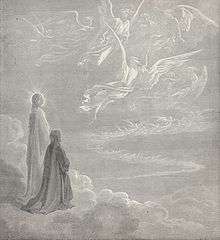
.jpg)

Latter Day Saints believe that angels either are the spirits of humans who are deceased or who have yet to be born, or are humans who have been resurrected or translated and have physical bodies of flesh and bones,[55] and accordingly Joseph Smith taught that "there are no angels who minister to this earth but those that do belong or have belonged to it."[56] As such, Latter Day Saints also believe that Adam, the first man, was and is now the archangel Michael,[57][58][59] and that Gabriel lived on the earth as Noah.[55] Likewise the Angel Moroni first lived in a pre-Columbian American civilization as the 5th-century prophet-warrior named Moroni.
Joseph Smith, Jr. described his first angelic encounter thus:[60]
"While I was thus in the act of calling upon God, I discovered a light appearing in my room, which continued to increase until the room was lighter than at noonday, when immediately a personage appeared at my bedside, standing in the air, for his feet did not touch the floor.He had on a loose robe of most exquisite whiteness. It was a whiteness beyond anything earthly I had ever seen; nor do I believe that any earthly thing could be made to appear so exceedingly white and brilliant ...
Not only was his robe exceedingly white, but his whole person was glorious beyond description, and his countenance truly like lightning. The room was exceedingly light, but not so very bright as immediately around his person. When I first looked upon him, I was afraid; but the fear soon left me."
Most angelic visitations in the early Latter Day Saint movement were witnessed by Joseph Smith and Oliver Cowdery, who both claimed (prior to the establishment of the church in 1830) to have been visited by the prophet Moroni, John the Baptist, and the apostles Peter, James, and John. Later, after the dedication of the Kirtland Temple, Smith and Cowdery claimed to have been visited by Jesus, and subsequently by Moses, Elias, and Elijah.[61]
People who claimed to have received a visit by an angel include the other two of the Three Witnesses: David Whitmer and Martin Harris. Many other Latter Day Saints, both in the early and modern church, have claimed to have seen angels, though Smith posited that, except in extenuating circumstances such as the restoration, mortals teach mortals, spirits teach spirits, and resurrected beings teach other resurrected beings.[62]
Islam

Angels (Arabic: ملائكة , Malāʾikah) are mentioned many times in the Qur'an and Hadith. Islam is clear on the nature of angels in that they are messengers of God. They have no free will, and can do only what God orders them to do.[63] An example of a task they carry out is that of testing individuals by granting them abundant wealth and curing their illness.[64] Believing in angels is one of the six Articles of Faith in Islam.
Some examples of angels in Islam:
- Jibrail: the archangel Gabriel (Jibra'il or Jibril) is an archangel who serves as a messenger from God.
- Michael (archangel): or Mikail, the angel of nature.
- Israfil (Arabic: إسرافيل, translit. Isrāfīl, Alternate Spelling: Israfel or Seraphim, Meaning: The Burning One [65] ), is the angel of the trumpet in Islam,[66] though unnamed in the Qur'an. Along with Mikhail, Jibrail and Izra'il, he is one of the four Islamic archangels.[65] Israfil will blow the trumpet from a holy rock in Jerusalem to announce the Day of Resurrection.[67] The trumpet is constantly poised at his lips, ready to be blown when God so orders.
- Darda'il: the angels who travel in the earth searching out assemblies where people remember God's name.
- Azrael is Azraa-eel عزرائيل or Izrail: the Angel of Death. No authentic reference of this in Quran or Hadeeth. Only referenced as angel of death or ملك الموت.
- Kiraman Katibin: the two angels who record a person's good and bad deeds.
- Mu'aqqibat: a class of guardian angels who keep people from death until its decreed time.
- Munkar and Nakir: the angels who test the faith of the dead in their graves. They ask the soul of the dead person questions. If the person fails the questions, the angels make the man suffer until the Day of Judgement. If the soul passes the questions, he will have a pleasant time in the grave until the Day of Judgement.
- Ridwan: the angel in charge of maintaining Jannat or Paradise.
- Maalik: the angel who keeps or guards hellfire.
- Harut and Marut (Arabic: هاروت وماروت) are two angels mentioned in the second Surah of the Qur'an, who were sent down to test the people at Babel or Babylon by performing deeds of magic. (Sura Al-Baqara, verse 102.) The Qur'an indicates that although they warned the Babylonians not to imitate them or do as they were doing, some members of their audience failed to obey and became sorcerers, thus damning their own souls.
Bahá'í Faith
In his Book of Certitude Bahá'u'lláh, founder of the Bahá'í Faith, describes angels as people who "have consumed, with the fire of the love of God, all human traits and limitations", and have "clothed themselves" with angelic attributes and have become "endowed with the attributes of the spiritual". 'Abdu'l-Bahá describes angels as the "confirmations of God and His celestial powers" and as "blessed beings who have severed all ties with this nether world" and "been released from the chains of self", and "revealers of God's abounding grace". The Bahá'í writings also refer to the Concourse on High, an angelic host, and the Maid of Heaven of Bahá'u'lláh's vision.[68]
Sikhism
The poetry of the holy scripture of the Sikhs – the Sri Guru Granth Sahib – figuratively mentions a messenger or angel of death, sometimes as Yam (ਜਮ – "Yam") and sometimes as Azrael (ਅਜਰਾਈਲੁ – "Ajraeel"):
- ਜਮ ਜੰਦਾਰੁ ਨ ਲਗਈ ਇਉ ਭਉਜਲੁ ਤਰੈ ਤਰਾਸਿ
- The Messenger of Death will not touch you; in this way, you shall cross over the terrifying world-ocean, carrying others across with you.
- — Sri Guru Granth Sahib, Siree Raag, First Mehl, p. 22.[69]
- ਅਜਰਾਈਲੁ ਯਾਰੁ ਬੰਦੇ ਜਿਸੁ ਤੇਰਾ ਆਧਾਰੁ
- Azraa-eel, the Messenger of Death, is the friend of the human being who has Your support, Lord.
- — Sri Guru Granth Sahib, Tilang, Fifth Mehl, Third House, p. 724.[70]
In a similar vein, the Sri Guru Granth Sahib talks of a figurative Chitar (ਚਿਤ੍ਰ) and Gupat (ਗੁਪਤੁ):
- ਚਿਤ੍ਰ ਗੁਪਤੁ ਸਭ ਲਿਖਤੇ ਲੇਖਾ ॥
- ਭਗਤ ਜਨਾ ਕਉ ਦ੍ਰਿਸਟਿ ਨ ਪੇਖਾ
- Chitar and Gupat, the recording angels of the conscious and the unconscious, write the accounts of all mortal beings, / but they cannot even see the Lord's humble devotees.
- — Sri Guru Granth Sahib, Aasaa, Fifth Mehl, Panch-Pada, p. 393.[71]
However, Sikhism has never had a literal system of angels, preferring guidance without explicit appeal to supernatural orders or beings.
Esotericism
Hermetic Qabalah
According to the Kabbalah as described by the Golden Dawn there are ten archangels, each commanding one of the choir of angels and corresponding to one of the Sephirot. It is similar to the Jewish angelic hierarchy.
| Rank | Choir of Angels | Translation | Archangel | Sephirah |
|---|---|---|---|---|
| 1 | Hayot Ha Kodesh | Holy Living Ones | Metatron | Keter |
| 2 | Ophanim | Wheels | Raziel | Chokmah |
| 3 | Erelim | Brave ones[72] | Tzaphkiel | Binah |
| 4 | Hashmallim | Glowing ones, Amber ones[73] | Tzadkiel | Chesed |
| 5 | Seraphim | Burning Ones | Khamael | Gevurah |
| 6 | Malakim | Messengers, angels | Raphael | Tipheret |
| 7 | Elohim | Godly Beings | Uriel | Netzach |
| 8 | Bene Elohim | Sons of Elohim | Michael | Hod |
| 9 | Cherubim | [74] | Gabriel | Yesod |
| 10 | Ishim | Men (man-like beings, phonetically similar to "fires") | Sandalphon | Malkuth |
Theosophy
In the teachings of the Theosophical Society, Devas are regarded as living either in the atmospheres of the planets of the solar system (Planetary Angels) or inside the Sun (Solar Angels) and they help to guide the operation of the processes of nature such as the process of evolution and the growth of plants; their appearance is reputedly like colored flames about the size of a human. It is believed by Theosophists that devas can be observed when the third eye is activated. Some (but not most) devas originally incarnated as human beings.[75]
It is believed by Theosophists that nature spirits, elementals (gnomes, undines, sylphs, and salamanders), and fairies can be also be observed when the third eye is activated.[76] It is maintained by Theosophists that these less evolutionarily developed beings have never been previously incarnated as humans; they are regarded as being on a separate line of spiritual evolution called the "deva evolution"; eventually, as their souls advance as they reincarnate, it is believed they will incarnate as devas.[77]
It is asserted by Theosophists that all of the above-mentioned beings possess etheric bodies that are composed of etheric matter, a type of matter finer and more pure that is composed of smaller particles than ordinary physical plane matter.[77]
Brahma Kumaris
The Brahma Kumaris uses the term "angel" to refer to a perfect, or complete state of the human being, which they believe can be attained through a connection with God.[78][79]
In art
In an address during a General Audience of 6 August 1986, entitled "Angels participate in the history of salvation", Pope John Paul II explained that "[T]he angels have no 'body' (even if, in particular circumstances, they reveal themselves under visible forms because of their mission for the good of people)."[39] Angels are however often depicted in painting and sculpture as male humans. Christian art perhaps reflects the descriptions in Revelation 4:6–8 of the Four Living Creatures (Greek: τὰ τέσσαρα ζῷα) and the descriptions in the Hebrew Bible of cherubim and seraphim (the chayot in Ezekiel's Merkabah vision and the Seraphim of Isaiah). However, while cherubim and seraphim have wings in the Bible, no angel is mentioned as having wings.[80]
The earliest known Christian image of an angel—in the Cubicolo dell'Annunziazione in the Catacomb of Priscilla (mid-3rd century)—is without wings. In that same period, representations of angels on sarcophagi, lamps and reliquaries also show them without wings,[81] as for example the angel in the Sacrifice of Isaac scene in the Sarcophagus of Junius Bassus (although the side view of the Sarcophagus shows winged angelic figures).
The earliest known representation of angels with wings is on the "Prince's Sarcophagus", discovered in the 1930s at Sarigüzel, near Istanbul, and attributed to the time of Theodosius I (379–395).[82] From that period on, Christian art has represented angels mostly with wings, as in the cycle of mosaics in the Basilica of Saint Mary Major (432–440).[83] Four- and six-winged angels, drawn from the higher grades of angels (especially cherubim and seraphim) and often showing only their faces and wings, are derived from Persian art and are usually shown only in heavenly contexts, as opposed to performing tasks on earth. They often appear in the pendentives of church domes or semi-domes. Prior to the Judeo-Christian tradition, in the Greek world the goddess Nike and the gods Eros and Thanatos were also depicted in human-like form with wings.
Saint John Chrysostom explained the significance of angels' wings:
They manifest a nature's sublimity. That is why Gabriel is represented with wings. Not that angels have wings, but that you may know that they leave the heights and the most elevated dwelling to approach human nature. Accordingly, the wings attributed to these powers have no other meaning than to indicate the sublimity of their nature.[84]
Angels are typically depicted in Mormon art as having no wings based on a quote from Joseph Smith ("An angel of God never has wings").[85]
In terms of their clothing, angels, especially the Archangel Michael, were depicted as military-style agents of God and came to be shown wearing Late Antique military uniform. This uniform could be the normal military dress, with a tunic to about the knees, an armour breastplate and pteruges, but was often the specific dress of the bodyguard of the Byzantine Emperor, with a long tunic and the loros, the long gold and jewelled pallium restricted to the Imperial family and their closest guards. The basic military dress was shown in Western art into the Baroque period and beyond (see Reni picture above), and up to the present day in Eastern Orthodox icons. Other angels came to be conventionally depicted in long robes, and in the later Middle Ages they often wear the vestments of a deacon, a cope over a dalmatic; this costume was used especially for Gabriel in Annunciation scenes—for example the Annunciation in Washington by Jan van Eyck.
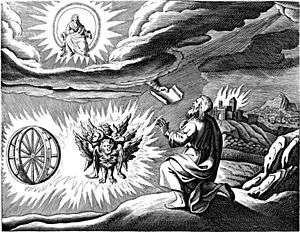
Some types of angels are described as possessing more unusual or frightening attributes, such as the fiery bodies of the Seraphim, and the wheel-like structures of the Ophanim.
See also
References
- 1 2 3 "Definition of ANGEL". www.merriam-webster.com. Retrieved 2016-05-02.
- 1 2 The Free Dictionary retrieved 1 September 2012
- ↑ Augustine of Hippo's Enarrationes in Psalmos, 103, I, 15, augustinus.it (Latin)
- 1 2 3 "ANGELOLOGY - JewishEncyclopedia.com". jewishencyclopedia.com. Retrieved 2016-05-02.
- ↑ Oxford Dictionaries, "angel"
- ↑ Beekes, R. S. P., Etymological Dictionary of Greek, Brill, 2009, p. 9.
- ↑ palaeolexicon.com; a-ke-ro, Palaeolexicon (Word study tool of ancient languages)
- ↑ "Mycenaean (Linear b) – English Glossary" (PDF). Retrieved 30 July 2012.
- ↑ Kosior, Wojciech. "The Angel in the Hebrew Bible from the Statistic and Hermeneutic Perspectives. Some Remarks on the Interpolation Theory". "The Polish Journal of Biblical Research", Vol. 12, No. 1 (23), pp. 55-70. Retrieved 22 November 2013.
- ↑ Lewis, James R., Oliver, Evelyn Dorothy, Sisung Kelle S. (Editor) (1996), Angels A to Z, Entry: Zoroastrianism, pp. 425–427, Visible Ink Press, ISBN 0-7876-0652-9
- ↑ Darmesteter, James (1880)(translator), The Zend Avesta, Part I: Sacred Books of the East, Vol. 4, pp. lx-lxxii, Oxford University Press, 1880, at sacred-texts.com
- ↑ Aristotle. Metaphysics. 1072a ff.
- ↑ Aristotle. Metaphysics. 1073a13 ff.
- 1 2 ""מַלְאָךְ," Francis Brown, S.R. Driver, and Charles A. Briggs, eds.: ''A Hebrew and English Lexicon of the Old Testament'' , p. 521". Archive.org. Retrieved 30 July 2012.
- ↑ Pope, Hugh. "Angels." The Catholic Encyclopedia. Vol. 1. New York: Robert Appleton Company, 1907. accessed 20 October 2010
- ↑ Frederick Copleston, A History of Philosophy, Volume 1, Continuum, 2003, p. 460.
- ↑ Baker, Louis Goldberg. Evangelical Dictionary of Biblical Theology: Angel of the Lord "The functions of the angel of the Lord in the Old Testament prefigure the reconciling ministry of Jesus. In the New Testament, there is no mention of the angel of the Lord; the Messiah himself is this person."
- 1 2 3 4 Coogan, Michael D. (2009). A Brief Introduction to the Old Testament. Oxford University Press.
- 1 2 3 4 "Angelology". The Jewish Encyclopedia. Retrieved 30 July 2012.
- ↑ Copleston, Frederick Charles (2003). A history of philosophy, Volume 1. Continuum International Publishing Group, p. 460. ISBN 0-8264-6895-0
- ↑ Sanhedrin 38b and Avodah Zerah 3b.
- ↑ Aleksander R. Michalak, Angels as Warriors in Late Second Temple Jewish Literature, Tuebingen: Mohr Siebeck, 2012.
- ↑ Hannah Darrell D., Michael and Christ: Michael Traditions and Angel Christology in Early Christianity, Tuebingen: Mohr Siebeck, 1999
- ↑ cf. Sanhedrin 95b
- ↑ Evans, Annette Henrietta Margaretha. "The development of Jewish ideas of angels: Egyptian and Hellenistic connections, ca. 600 BCE to ca. 200 CE", Thesis (PhD (Ancient Studies))-University of Stellenbosch, 2007.
- ↑ Proverbio, Cecelia. "La Figura Dell'Angelo Nella Civilta' Paleochristiana" (2007), pp. 25–38, Libreria Hoepli
- ↑ Augustine, En. in Ps. 103, 1, 15: PL 37, 1348
- ↑ "Angels", ZENIT International News Agency, December 9, 2002
- ↑ Ludlow, Morwenna (2012). Brakke, David, ed. "Demons, Evil, and Liminality in Cappadocian Theology" (PDF). Journal of Early Christian Studies. Baltimore: Johns Hopkins University Press. 20 (2): 179–211 [183]. doi:10.1353/earl.2012.0014. ISSN 1067-6341. Retrieved 11 November 2012.
- ↑ Proverbio(2007), pp. 29–38; cf. summary in Libreria Hoepli and review in La Civiltà Cattolica, 3795–3796 (2–16 August 2008), pp. 327–328.
- ↑ "When Did God Create Angels?". Apologetics Press. Retrieved 30 July 2012.
- ↑ Thomas Aquinas. "46". Summa contra Gentiles. 2.
- ↑ Thomas Aquinas. Summa Theologica. Treatise on Angels. Newadvent.org.
- ↑ Aquinas, Thomas. De substantiis separatis. Josephkenny.joyeurs.com.
- ↑ "BibleGateway, Matthew 24:36". Biblegateway.com. Retrieved 30 July 2012.
- 1 2 Pope, Hugh. "Angels." The Catholic Encyclopedia. Vol. 1. New York: Robert Appleton Company, 1907. 11 Jan. 2015
- ↑ "BibleGateway, Luke 22:43". Biblegateway.com. Retrieved 30 July 2012.
- ↑ Ann Ball, 2003 Encyclopedia of Catholic Devotions and Practices ISBN 0-87973-910-X page 123
- 1 2 "Angels Participate In History Of Salvation". Vatican.va. 6 August 1986. Archived from the original on 20 October 2012. Retrieved 30 July 2012.
- ↑ Congregation for Divine Worship and Discipline of the Sacraments, "Directory on Popular Piety and the Liturgy", §217
- ↑ Swedenborg, Emanuel. Heaven and Hell, 1758. Rotch Edition (revised). New York: Houghton, Mifflin and Company, 1907, in The Divine Revelation of the New Jerusalem (2012), n. 74.
- ↑ Arcana Coelestia, n. 459.
- ↑ Heaven and Hell, n. 51-53.
- ↑ Heaven and Hell, n. 311
- ↑ Heaven and Hell, n. 416
- ↑ Heaven and Hell, n. 387-393.
- ↑ Swedenborg, Emanuel. Heavenly Arcana (or Arcana Coelestia), 1749-58 (AC). Rotch Edition (revised). New York: Houghton, Mifflin and Company, 1907, in The Divine Revelation of the New Jerusalem (2012), n. 8192.3.
- ↑ Heaven and Hell, n. 291-298.
- ↑ Arcana Coelestia, n. 50, 697, 968.
- ↑ Arcana Coelestia, n. 227.
- ↑ Arcana Coelestia, n. 784.2.
- ↑ Heaven and Hell, n. 76.
- ↑ Arcana Coelestia, n. 5992.3.
- ↑ "God's messengers, those individuals whom he sends (often from his personal presence in the eternal worlds), to deliver his messages (Luke 1:11–38); to minister to his children (Acts 10:1–8, Acts 10:30–32); to teach them the doctrines of salvation (Mosiah 3); to call them to repentance (Moro. 7:31); to give them priesthood and keys (D.&C. 13; 128:20–21); to save them in perilous circumstances (Nehemiah 3:29–31; Daniel 6:22); to guide them in the performance of his work (Genesis 24:7); to gather his elect in the last days (Matthew 24:31); to perform all needful things relative to his work (Moro. 7:29–33)—such messengers are called angels.".
- 1 2 "LDS Bible Dictionary-Angels". Scriptures.lds.org. 21 February 2012. Retrieved 30 July 2012.
- ↑ Doctrine and Covenants 130:4–5.
- ↑ http://www.lds.org/manual/gospel-principles/chapter-6-the-fall-of-adam-and-eve "Chapter 6: The Fall of Adam and Eve," Gospel Principles (Salt Lake City, Utah: LDS Church, 2011) pp. 26–30.
- ↑ "D&C 107:24". Scriptures.lds.org. 21 February 2012. Retrieved 30 July 2012.
- ↑ Mark E. Petersen, "Adam, the Archangel", Ensign, November 1980.
- ↑ "Joseph Smith–History 1:30-33". Scriptures.lds.org. 21 February 2012. Retrieved 30 July 2012.
- ↑ "D&C 110". Scriptures.lds.org. 21 February 2012. Retrieved 30 July 2012.
- ↑ Robert J. Matthews, "The Fulness of Times", Ensign, December 1989.
- ↑ Mirza Tahir Ahmad. An Elementary Study of Islam. Islam International Publications. p. 12. ISBN 1-85372-562-5.
- ↑ Sahih al-Bukhari, 4:56:670
- 1 2 Lewis, James R., Oliver, Evelyn Dorothy, Sisung Kelle S. (Editor) (1996), Angels A to Z, p. 224, Visible Ink Press, ISBN 0-7876-0652-9
- ↑ Webster, Richard (2009). Encyclopedia of angels (1st ed.). Woodbury, Minn.: Llewellyn Publications. p. 97. ISBN 978-0-7387-1462-2.
- ↑ "Israfil". Encyclopaedia. Britannica. Retrieved 20 November 2012.
- ↑ Smith, Peter (2000). "angels". A concise encyclopedia of the Bahá'í Faith. Oxford: Oneworld Publications. pp. 38–39. ISBN 1-85168-184-1.
- ↑ "Sri Granth: Sri Guru Granth Sahib". srigranth.org. Retrieved 24 May 2015.
- ↑ "Sri Granth: Sri Guru Granth Sahib". srigranth.org. Retrieved 24 May 2015.
- ↑ "Sri Granth: Sri Guru Granth Sahib". srigranth.org. Retrieved 24 May 2015.
- ↑ Strong's Hebrew: 691. אֶרְאֵל (erel) - perhaps a hero
- ↑ Strong's Hebrew: 2830. חַשְׁמַל (chashmal) - perhaps amber
- ↑ Strong's Hebrew: 3742. כְּרוּב (kerub) - probably an order of angelic beings
- ↑ Hodson, Geoffrey, Kingdom of the Gods ISBN 0-7661-8134-0—Has color pictures of what Devas supposedly look like when observed by the third eye—their appearance is reputedly like colored flames about the size of a human. Paintings of some of the devas claimed to have been seen by Hodson from his book "Kingdom of the Gods":
- ↑ "Eskild Tjalve's paintings of devas, nature spirits, elementals and fairies:". Web.archive.org. 21 November 2002. Archived from the original on 21 November 2002. Retrieved 30 July 2012.
- 1 2 Powell, A.E. The Solar System London:1930 The Theosophical Publishing House (A Complete Outline of the Theosophical Scheme of Evolution) See "Lifewave" chart (refer to index)
- ↑ Basava Journal, Volume 19. Basava Samiti, 1994 (Bangalore, India).
- ↑ Peace & purity: the story of the Brahma Kumaris : a spiritual revolution By Liz Hodgkinson
- ↑ "Angel", The International Standard Bible Encyclopedia James Orr, editor, 1915 edition.
- ↑ Proverbio (2007), pp. 81–89; cf. review in La Civiltà Cattolica, 3795–3796 (2–16 August 2008), pp. 327–328.
- ↑ Proverbio (2007) p. 66.
- ↑ Proverbio (2007), pp. 90–95
- ↑ Proverbio (2007) p. 34.
- ↑ "History of the Church, 3:392". Institute.lds.org. Retrieved 30 July 2012.
Further reading
- Proverbio, Cecilia (2007). La figura dell'angelo nella civiltà paleocristiana (in Italian). Assisi, Italy: Editrice Tau. ISBN 88-87472-69-6.
- Cheyne, James Kelly (ed.) (1899). Angel. Encyclopædia Biblica. New York, Macmillan.
- Driver, Samuel Rolles (Ed.) (1901) The book of Daniel. Cambridge UP.
- Davidson, A. B. (1898). "Angel". In James Hastings. A Dictionary of the Bible. I. pp. 93–97.
- Oosterzee, Johannes Jacobus van. Christian dogmatics: a text-book for academical instruction and private study. Trans. John Watson Watson and Maurice J. Evans. (1874) New York, Scribner, Armstrong.
- Smith, George Adam (1898) The book of the twelve prophets, commonly called the minor. London, Hodder and Stoughton.
- Bamberger, Bernard Jacob, (15 March 2006). Fallen Angels: Soldiers of Satan's Realm. Jewish Publication Society of America. ISBN 0-8276-0797-0
- Bennett, William Henry (1911), "Angel", Encyclopædia Britannica, 11th ed., Vol. II, Cambridge: Cambridge University Press, pp. 4–6.
- Briggs, Constance Victoria, 1997. The Encyclopedia of Angels : An A-to-Z Guide with Nearly 4,000 Entries. Plume. ISBN 0-452-27921-6.
- Bunson, Matthew, (1996). Angels A to Z: A Who's Who of the Heavenly Host. Three Rivers Press. ISBN 0-517-88537-9.
- Cruz, Joan Carroll, OCDS, 1999. Angels and Devils. TAN Books and Publishers, Inc. ISBN 0-89555-638-3
- Davidson, Gustav. A Dictionary of Angels: Including the Fallen Angels. Free Press. ISBN 0-02-907052-X
- Graham, Billy, 1994. Angels: God's Secret Agents. W Pub Group; Minibook edition. ISBN 0-8499-5074-0
- Guiley, Rosemary, 1996. Encyclopedia of Angels. ISBN 0-8160-2988-1
- von Heijne, Camilla, 2010. The Messenger of the Lord in Early Jewish Interpretations of Genesis. BZAW 412. De Gruyter, Berlin/New York, ISBN 978-3-11-022684-3
- von Heijne, Camilla, 2015 "Angels" pp. 20–24 in The Oxford Encyclopedia of the Bible and Theology, vol. 1. Oxford University Press, New York. ISBN 978-0-19-023994-7
- Jastrow, Marcus, 1996, A dictionary of the Targumim, the Talmud Bavli and Yerushalmi, and the Midrashic literature compiled by Marcus Jastrow, PhD., Litt.D. with and index of Scriptural quotatons, Vol 1 & 2, The Judaica Press, New York
- Kainz, Howard P., "Active and Passive Potency" in Thomistic Angelology Martinus Nijhoff. ISBN 90-247-1295-5
- Kreeft, Peter J. 1995. Angels and Demons: What Do We Really Know About Them? Ignatius Press. ISBN 0-89870-550-9
- Lewis, James R. (1995). Angels A to Z. Visible Ink Press. ISBN 0-7876-0652-9
- Melville, Francis, 2001. The Book of Angels: Turn to Your Angels for Guidance, Comfort, and Inspiration. Barron's Educational Series; 1st edition. ISBN 0-7641-5403-6
- Michalak, Aleksander R. (2012), Angels as Warriors in Late Second Temple Jewish Literature.Mohr Siebeck. ISBN 978-3-16-151739-6.
- Muehlberger, Ellen (2013). Angels in Late Ancient Christianity. Oxford University Press. ISBN 978-0199931934
- Ronner, John, 1993. Know Your Angels: The Angel Almanac With Biographies of 100 Prominent Angels in Legend & Folklore-And Much More! Mamre Press. ISBN 0-932945-40-6.
- Smith, William Robertson (1878), "Angel", Encyclopædia Britannica, 9th ed., Vol. II, New York: Charles Scribner's Sons, p. 26–28.
- Swedenborg E.Heaven and its Wonders and Hell From Things Heard and Seen (Swedenborg Foundation 1946), ISBN 0-554-62056-1 (Detailed information on angels and their life in heaven)
- Swedenborg, E. Wisdom's Delight in Marriage ("Conjugial") Love: Followed by Insanity's Pleasure in Promiscuous Love (Swedenborg Foundation 1979 ISBN 0-87785-054-2) (Extensive review of angelic marriage)
External links
| Wikimedia Commons has media related to Angels. |
| Wikiquote has quotations related to: Angels |
- Zoroastrian angels
- Jewish Encyclopedia entry on angels
- Angels in Islam
- Congregation for Divine Worship and the Discipline of the Sacraments. Directory of Popular Piety and the Liturgy, §§ 212-217, "The Holy Angels, Vatican City, December 2001

